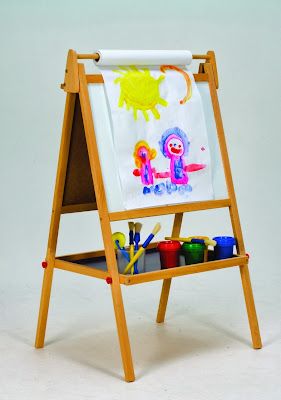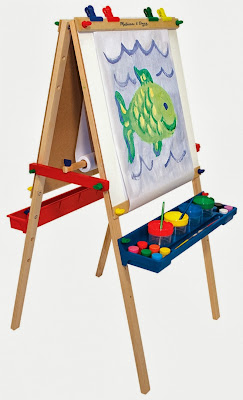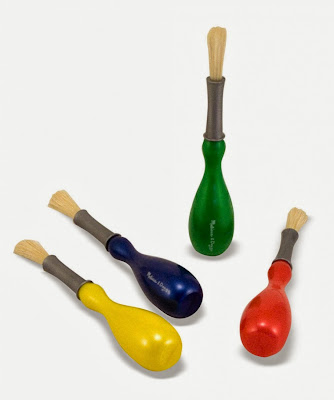Learning with Easels and Paints
Mums and dads
the whole world over know full well that children love getting dirty: puddles
will be jumped in; water will be splashed; mud will be piled up or thrown
about; worms and creepy crawlies will be examined (and occasionally eaten); and
food is as likely to find its way onto the floor or all over hands and faces as
it is to find its way into a mouth. As mucky and messy as they are, children
are naturally inquisitive and love experimenting with whatever comes to hand. WoodenToyShop’s selection of children’s easels and easel
accessories offers parents and carers a way to channel children’s energy and
enthusiasm into educational and developmental play while satisfying those
undeniable juvenile demands to make a mess.
the whole world over know full well that children love getting dirty: puddles
will be jumped in; water will be splashed; mud will be piled up or thrown
about; worms and creepy crawlies will be examined (and occasionally eaten); and
food is as likely to find its way onto the floor or all over hands and faces as
it is to find its way into a mouth. As mucky and messy as they are, children
are naturally inquisitive and love experimenting with whatever comes to hand. WoodenToyShop’s selection of children’s easels and easel
accessories offers parents and carers a way to channel children’s energy and
enthusiasm into educational and developmental play while satisfying those
undeniable juvenile demands to make a mess.
Lots of us
will remember taking one of Daddy’s old shirts into nursery or to school where
we would put it on backwards to keep our clothes or uniforms free from paint or
chalk. Standing at an easel was a huge treat in school and painting a picture
of your family and house is a rite of passage for many children. Of course,
while children are happy to ‘play’, grownups should be aware of the many
benefits of artistic play. Starting with a simple paintbrush, piece of chalk or
magic marker pen, all of these help children develop and improve fine motor
skills: in this case, learning to grip and use ‘tools’ is an essential life
skill that we all take for granted.
will remember taking one of Daddy’s old shirts into nursery or to school where
we would put it on backwards to keep our clothes or uniforms free from paint or
chalk. Standing at an easel was a huge treat in school and painting a picture
of your family and house is a rite of passage for many children. Of course,
while children are happy to ‘play’, grownups should be aware of the many
benefits of artistic play. Starting with a simple paintbrush, piece of chalk or
magic marker pen, all of these help children develop and improve fine motor
skills: in this case, learning to grip and use ‘tools’ is an essential life
skill that we all take for granted.
Having
selected their preferred tool, children then have the choice of which colour to
paint, chalk or mark. Colours play such an important role in our lives and
colour is one of the earliest aspects of life and the world around us that
children learn. This helps them to distinguish and categorise the world around
them. It helps them with communication and language – colour is a very useful
tool for identifying describing objects, for example. Similarly, painting or
drawing different shapes gives children another option for understanding and
describing the objects around them.
selected their preferred tool, children then have the choice of which colour to
paint, chalk or mark. Colours play such an important role in our lives and
colour is one of the earliest aspects of life and the world around us that
children learn. This helps them to distinguish and categorise the world around
them. It helps them with communication and language – colour is a very useful
tool for identifying describing objects, for example. Similarly, painting or
drawing different shapes gives children another option for understanding and
describing the objects around them.
Of course, creative
and unstructured play like this encourages children to use their young imaginations
and develop a sense of their own personalities: the things that they draw and
paint can reflect their interests, even at an early age. This kind of play also
allows children to work through and express some of the things in their lives
that matter to them or are bothering them, all in a relaxed and open
environment.
and unstructured play like this encourages children to use their young imaginations
and develop a sense of their own personalities: the things that they draw and
paint can reflect their interests, even at an early age. This kind of play also
allows children to work through and express some of the things in their lives
that matter to them or are bothering them, all in a relaxed and open
environment.
As children
grow older, they can use easels, white boards and chalk boards to learn numbers
and letters and basic spelling and mathematics. Given the space of a magnetic
board rather than a page in an exercise book, children can be more relaxed
about forming letters and numbers and this early play can be useful to give
them a head start in more formal education.
grow older, they can use easels, white boards and chalk boards to learn numbers
and letters and basic spelling and mathematics. Given the space of a magnetic
board rather than a page in an exercise book, children can be more relaxed
about forming letters and numbers and this early play can be useful to give
them a head start in more formal education.
It seems a
shame that so many of us put down our paint brushes when we leave school and
never go back to an easel or sketch book. The benefits and enjoyment of such a
simple activity should be enjoyed by us grownups as well as our little angels.
shame that so many of us put down our paint brushes when we leave school and
never go back to an easel or sketch book. The benefits and enjoyment of such a
simple activity should be enjoyed by us grownups as well as our little angels.
This is a sponsored post





